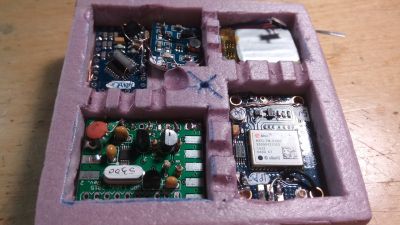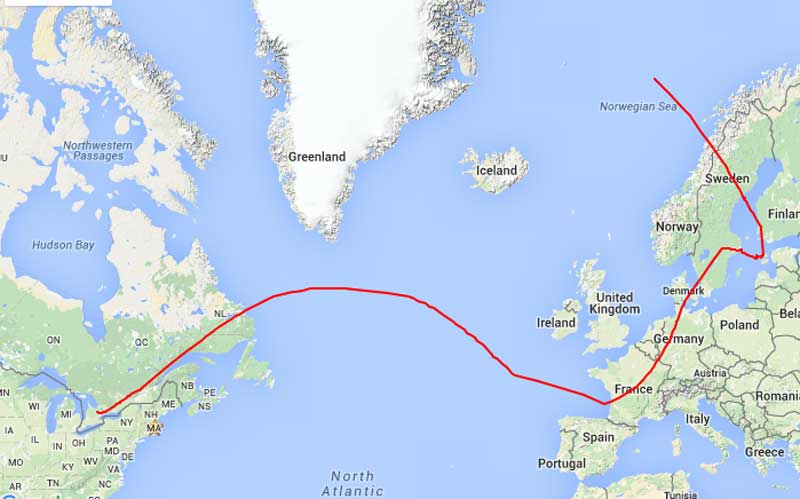For the past few months, [David VE3KCL] has been launching balloons from his Canadian home fitted with radio transmitters. Nothing unusual there: quite a few people do this, including schools, hackerspaces, and individuals. What is remarkable is how far he has gotten. His S-4 flight in August of this year crossed the Atlantic, reached France and took a tour of Germany, Denmark, Sweden, Finland and Norway before finally landing in the Norwegian Sea. That’s over 10,000 kilometers (6200 miles): not bad for a couple of party balloons strung together.

Although the distance these balloons have travelled is quite remarkable, the interesting part is how [David] is tracking the balloons. Cell phones obviously won’t work over the Atlantic, and satellite transmitters are expensive, so he used a low-cost transmitter that was programmed to broadcast using a variety of Ham radio signals. The most effective seems to be WSPRnet (the Weak Signal Propagation Network), a system used by Hams to see how far low strength signals will go. This system relies on Hams leaving their receivers on and running software that uploads the received signals to a central server.
By cleverly encoding information such as height and position into this signal, he was able to turn this worldwide network into a tracking network that would report the balloon’s position pretty much anywhere on the globe. [David] is continuing to launch balloons: his latest went up on the 24th of September and travelled over 4300km (2600 miles) before the signal was lost over the Atlantic.
















Keep on flying! VE7ZXD
at what point does it shift from good experiment to irresponsible pollution? just how many people are doing this?
I recognize your concern, but I also think one needs to keep *perspective*. By that, I mean that the consumption of *any commercial product* you can imagine most likely outweighs this scientifically valuable (and educational) project by a factor of several million.
At what point does it shift from good experiment to being sucked into a jet air intake? Yes I realise the altitudes recorded are low, but I also did not see any mention of an altitude restriction mechanism either
Apart from that, an interesting experiment to be sure.
On the one hand, jet engines are pretty good at taking (small) stuff in and shredding it to dust. On the other, the sky is high and wide enough that the chance of a single small thing like this encountering any jet engine when sent on a semi-random path is pretty much zero.
I wouldn’t get concerned until he launched like a few thousand probes like this daily.
Oh, they do that all right. Problem is that it generally knackers the engine in the process. Discounting the batteries, there’s a fair amount of mass in there that you wouldn’t want hitting an aeroplane at 300Kts. In mitigation, big sky theory :)
foil balloons show up on radar, if he wasn’t using foil balloons he would have to include a radar reflector, like everyone does…
Millions upon millions
Don’t worry about the amateurs.
According to http://www.noaa.gov/features/02_monitoring/balloon.html The National Weather Service recovers less than 20 percent of the 75,000 radiosondes released each year.
They’re seeding the planet with high technology for the archaeologists of the future to discover, thousands of years after the next big asteroid hit. Most of them will dismiss it as silly nonsense that there could have been any prior civilization as advanced or more than theirs.
Not likely. When our civilization collapses, the likelihood of an advanced civilization arising without access to easily exploitable oil reserves is pretty much zero, so by the time a sufficiently advanced society arises, the entire surface of the globe will likely have been subducted taking all evidence of us with it.
Counterpoint: fossilized pre-cambrian lifeforms.
Healthy, by posting your snarky comments, you’ve irresponsibly caused tens of thousands of computers to use additional electricity. Just how many people ARE there like you.
The balloon launcher is VE3KCL, not VE3KL. The latter was an engineering professor of mine at McMaster University in the 1990s (and chair of the electrical engineering department). Really nice guy, too.
Chris thanks for pointing that out: I have made that correction.
See also: http://hackaday.com/2015/07/05/pico-space-balloon-circumnavigates-the-globe-twice/
It’s crazy amazing what people can do with so little helium.
You missed an important point in the story of the Trans-Atlantic balloon… The man who came up with idea, wrote the code, in C, built the prototype and figured out how to do the WSPR telemetry was Hans Summers…. he got no mention.. He is a man you should Google.
David VE3KCL
I like it.
Is there an Arduino in there somewhere?